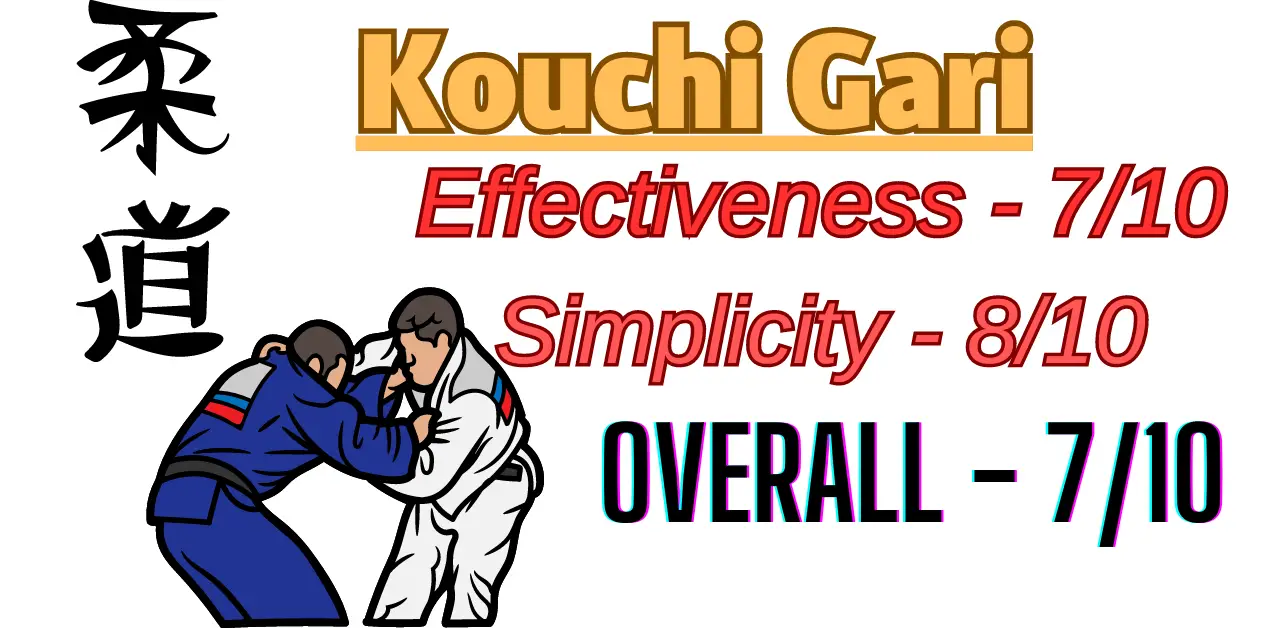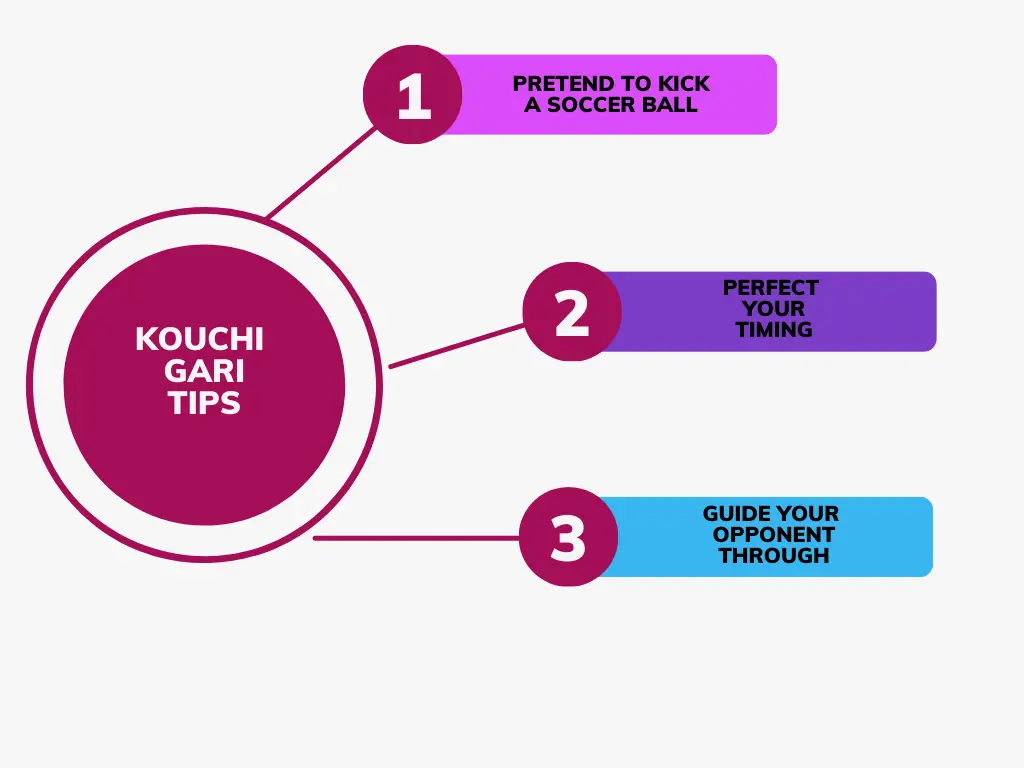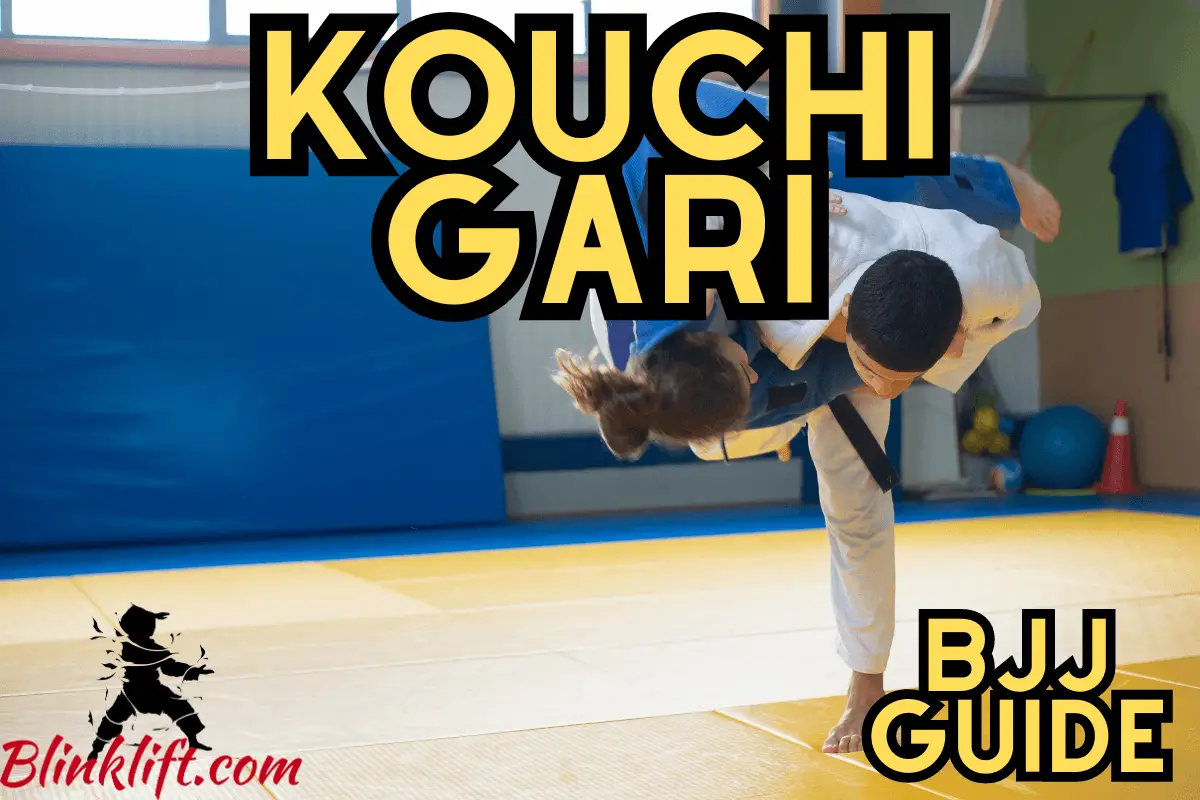The Kouchi Gari is one of the most effective and influential takedowns which are taught in BJJ and Judo. They allow you to transition the fight from a standing position to the ground. And if you’re the one initiating the takedown, you’ll have the upper hand.
So whether you’re a novice or advanced grappler, you’ll benefit from reading this article, especially if one of your goals is to become a better grappler. And let’s face it, who doesn’t want to become a better grappler?
This website is about taking your martial arts journey to the next level. You’ll be able to do that through constant learning, which is what I preach with this website. This is how it first started and it remained my motivation all along.
Another great thing about takedowns, including the Kouchi Gari move, is that they give you points in competitions (in BJJ.) In Judo, you’ll be able to Ippon your opponent, giving you the win. So you can’t go wrong by learning takedowns.
This was the best introduction I could think of. Hopefully, you’re ready to start learning more about the Kouchi Gari takedown and hone it to the best of your ability.
With great knowledge, comes great opportunities, so stay tuned for more!

What is the Kouchi Gari Takedown?
The first section of this article will cover the basic details of the Kouchi Gari Takedown, both for BJJ and Judo. However, there’s something you should know first. I’ve thoughtfully ordered the article the way it is. Meaning that you’ll learn the most if you don’t skip any sections, even if you think you already know what I’m about to talk about. I make sure to include ninja tips to help you learn and perfect your takedowns and common mistakes novice grapplers make.
These will all help you learn the Kouchi Gari faster while maintaining a solid foundation and perfecting your execution. So, what is the Kouchi Gari takedown and when is it best used?
In Judo, the Kouchi Gari is classified as one of the original 40 throws, categorized as a foot technique. It’s effective because it utilizes throwing your opponent off-balance by hooking their ankle area and pushing it outward while throwing them off-balance by pulling their upper bodies.
In BJJ, it’s often referred to as an Inside Trip, and you can imagine why. The execution will be the same as that of Judo, which includes tripping the opponent’s inner leg (typically in the ankle) to off-balance them and take them down to the ground.
And this is the foundation knowledge you want to have before you begin learning. I know you’ve been waiting long enough, so let’s start with the practical steps to perform it flawlessly!
How to perform the Kouchi Gari Takedown
A solid basis will grant you the ability to progress quicker than you ever thought possible. It’ll also allow you to learn the more advanced material without it taking too long. There’s no going wrong with investing a lot of time into learning the foundation of something, especially in martial arts.
So here are the basic steps of the Kouchi Gari Takedown:
The first step is to start in a standing position and establish an upper-body grip. The most common one is a double same-side grip. If you’re unfamiliar with the terminology, it’s when you grip the opponent’s sleeve, which is on the same side. So your right-hand grips his left arm’s sleeve and the other way around.
The second step is to step forward and place your foot as close as possible to his ankle. This is the most critical step to get right if you want to perform this takedown flawlessly. The sides you want to choose are as follows: if you’re targeting the opponent’s right leg, use your right leg (cross-side.) The same goes for the left side.
Next up, you want to sweep their ankle outward using your foot. This is what’s going to off-balance opponent. You want to imagine kicking a soccer ball. This will give your kick a full range of motion instead of just a partial one.
The fourth step is to pull your opponent’s upper body to finish the takedown. When you kick your opponent’s ankle outward, he should already be on the verge of falling. That’s great. What you want to do now is to pull their upper body, using your upper body grips, to take them down. The direction in which you pull them should complement the takedown.
And lastly, you follow through by attaining a more dominant position. This is a step many grapplers forget. After you take your opponent down, you want to follow through and attain a more dominant position. But more on that later.
Kouchi Gari Variations
Our next topic will be variations. This is something you want to perfect, as it’ll help you broaden your knowledge base and amp up your success rate.
Let’s imagine two grapplers: the first only knows 2 takedowns while the other 20. Who, in your opinion, is more likely to take his opponent down? From my experience, I’m confident that, in most cases, the second grappler will be able to take his opponent down and gain the upper hand.
That’s why you should never stop learning. Really, your goal should be to invest as many resources as possible to learn as many variations and moves as possible, which is why I decided to invest an entire part in this topic.
By the way, I recommend bookmarking this article, as it’ll help you gain easy access back to this article. And you want to have it in easy access, as it’ll help you practice the variations better, without having to remember them.

So without further ado, here are 3 additional variations you want to learn and practice when you’re done reading this article.
#1 – Leaning Kouchi Gari
The first variation we’ll review is one I love to call the Leaning Kouchi Gari. This one includes one small detail that you want to change and you’ll be able to catch your opponent off-guard while making this takedown more powerful.
What is that detail?
Instead, of stepping forward and going for the sweep, you’ll be stepping to the side and forward, leaning on the opponent’s upper body, and then going for the sweep. When you lean on your opponent, you have more leverage and he doesn’t know what’s going on.
By doing so, you’ll be able to leverage the leaning motion to catch your opponent off-guard, place your foot, and go for the sweep. And remember, you don’t want to lean on your opponent in the standard variation.
Experiment with this variation to understand which one you like most. Mat experience will be the best to understand if you prefer leaning on your opponent or avoiding that as a whole.
#2 – Two-on-one grip Kouchi Gari
The 2nd variation we’ll review is going to include mostly the same steps as the standard one. So what makes it different? Instead of gripping two sleeves, you’ll grab one. Essentially, you’ll target one of the opponent’s arms, which has to be on the same side as the leg you’re targeting.
Frankly, this brings you more control. Think about it. Instead of having partial control over all of the opponent’s upper body, you’ll have complete control over half, which I believe is better.
Have a look at the video below to watch what this looks like
#3 – Fake Hook Kouchi Gari
For the last variation, I wanted to include something you can play around with. This variant will include a fake before you drive yourself in and trip the opponent. I highly recommend you play around with it to see just how beneficial it can be.
This variation is best used when you think your opponent knows you’re going for the Kouchi Gari. In that case, you want to use a fake to catch him off-guard and make it work.
It still works the same with the off-balancing part. However, it’s different because you’ll start by grabbing only one of your opponent’s sleeves, turning, and lifting his arm. When you do that, he’ll think you’re going for a big turn takedown.
Instead, you now want to return to your normal Kouchi Gari execution by stepping in, placing your foot near his targeted ankle, sweeping it outward, and using your upper body to take him down.
And don’t forget to attain a dominant position.
Kouchi Gari Tips
And now, let’s begin by diving in deeper and reviewing various tips you want to know about before you get on the mat to practice. These tips will help you learn this takedown faster while finding more success with it.
And finding more success with it—is critical. The reason for that is that the more success you’ll find using the Kouchi Gari, the more motivated you’ll be to continue training and learning more. That’s why I preach reading the entire article and not one section alone.
So keep that in mind. And now, let’s get motivated!

#1 – Pretend you’re kicking a soccer ball
The first tip will allow you to perfect the sweeping motion with your leg. Your primary focus should not be to sweep his leg outward, although that’s what you’re doing. So if you focus too much on sweeping his leg, you won’t be able to gain full range of motion.
Therefore, your best choice is to pretend you’re kicking a soccer ball when you go for the leg sweep. That’s how you’ll gain a full range of motion, which will lead to a great off-balancing and an overall more fulfilling experience.
#2 – Perfect your timing
The second tip relates to the entry part. The last thing you want to happen is to enter into your opponent’s comfort zone without absolutely flawless timing.
Think about it. You’re going on the offense. This will leave you vulnerable to the opponent’s attacks if you’re incapable of following through. And the best way to follow through is to have perfect timing.
So now that you understand that perfect timing is key, let’s see which is the best time for you to enter and go for the sweep.
The absolute best time to enter the opponent’s comfort zone is when he’s stepping backward and then forward.
Let me explain.
When your opponent steps backward and then forward, he’s (1) leaning on his leg, making him vulnerable to your sweep, and (2) least expects you to attack.
The more movement there is involved, the better your chances will be. For example, if you attack your opponent when both of you are still, he’ll see it coming from a mile away. Thus, it’ll be worth it to take the time to find the perfect time to enter and Kouchi Gari him until he’s on the ground!
#3 – Guide your opponent forward (with your hand)
And now, for the last tip, you want to guide your opponent forward with your upper body grip. By now, you should understand that you want to use your opponent’s upper body to ensure you take him to the ground. That’s all perfect. However, many grapplers ignore this step and only use their legs as the sole off-balance force.
That’s a big mistake.
You want to avoid that by using your arms to guide his upper body to ensure you’re off-balancing him enough.
Kouchi Gari Common Mistakes
In this part of the article, we’ll review 3 mistakes you must avoid perfecting your Kouchi Gari execution. I want to invite you to bookmark this article, so you can have easy access throughout your BJJ journey.
There’s simply too much to implement from this article. You can’t go and implement 3000 words into your BJJ game at once. That’ll be too difficult. So you want to constantly return to it and work on a few things simultaneously. And once you’re done, you can advance through.
So if you’re serious about your training, bookmark this article.
#1 – Not following through
The first common mistake I see is not following through. I see this all the time! Not enough grapplers understand the basic concept of following through and attaining a more dominant position.
If you’re doing Judo, you must pin your opponent to the ground once you take him down. This will give you a better chance to get the Ippon and the victory.
If you’re in BJJ, you must attain a more dominant position, so you can gain more points in a tournament and keep the advantage on your side. I think it’s quite simple to understand.
Your best options are to attain the Scarf Hold position, Standard Side Control, Knee on Belly, North-South position, or even attain the Full Mount! These are all valid options you can transition to if you want to maintain the upper hand in the fight.
#2 – Improper timing
The 2nd mistake I see all the time, especially amongst novice grapplers, is improper timing. Attacking when the opponent is ready to defend the most—is a fatal mistake.
Assuming your opponent is semi-capable, what usually will happen is that he’ll be able to counter your Kouchi Gari and go for his own attack.
Do you know when you’re most vulnerable? You’re most vulnerable when you’ve attacked the opponent and failed. Therefore, if you do end up attacking, ensure your opponent doesn’t expect it, which is done through careful observation.
And again, the best time to attack will be when your opponent steps backward and then forward while leaning on one of his legs. The leg he’s leaning on has to be the one you’ll target for your takedown.
#3 – Ignoring the opponent’s upper body
Let’s now dive straight into the last common mistake I see with the Kouchi Gari often, which is ignoring your opponent’s upper body.
You have a certain level of control you can achieve over your opponent. Typically, the best control you can have is when you control his upper and lower body together. This is quite easy to understand.
However, it seems that many grapplers understand this concept but still manage to ignore his upper body entirely. You must follow through by pulling his upper body in the direction of the takedown.
Imagine the Kouchi Gari scenario in your head right now. If you sweep his right leg outward (to his right), in which direction do you want to pull him? That’ll be to his left. So then, you have these pull/push motions that compliment each other and off-balance your opponent to a point where he can’t resist!
Which martial arts teach the Kouchi Gari?
Here are the martial arts that teach the Kouchi Gari Takedown:
- BJJ
- Judo
- Sambo
- Combat Sambo
It’s important to note that it’ll be taught slightly differently in each martial art. And also, it might be taught in other fighting styles as well, such as various Chinese Martial Arts. However, it’s not as common as these ones.
Final Words
Let me wrap up this article by saying good job. You’re a part of the few who have read the entire article and got thus far. So give yourself a pat on the shoulder.
Constant learning is the source of progression and motivation in all realms of life. However, constant learning with a lack of implementation equals a low progression rate.
So your next step is to get on the mat and start training. Don’t ignore getting on the mat and gaining experience, as this is the primary force of your progression. Regardless of which grappling martial art you’re doing, you must get on the mat and implement the things you’ve learned in this article.
The Kouchi Gari, however, isn’t the most effective takedown out there. Follow this link to learn about BJJ’s most effective and influential takedowns you want to know about to call yourself a decent grappler.
You can also sign up for our Email Newsletter to keep up with our blog posts and gain access to free martial arts/self-improvement courses!

Here are other articles you’d enjoy reading:
Arm Drag Takedown – Complete Fighting Breakdown
Foot Sweep Guide (For BJJ, Judo, and Wrestling)
Seoi Nage – Takedown Breakdown (BJJ & Judo)
BJJ 101 – Double Leg Takedown (Variations & Finishes
Single Leg Takedown 101 – BJJ Comprehensive Guide
Ankle Pick 101 (BJJ) – How to Execute Properly

